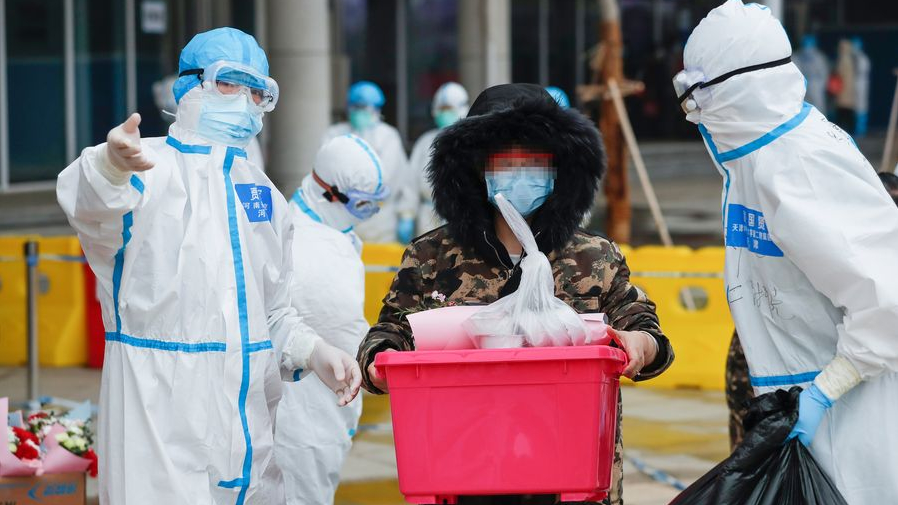
Editor's note: Iram Khan is a Pakistan-based commentator on international and commercial affairs. The article reflects the author's opinions, and not necessarily the views of CGTN.
As China is entering the final stages of defeating COVID-19, the stream of negative comments from sections of the Western media is showing no signs of slowing down. The insensitivity in the face of a calamity speaks of the unfortunate disregard for the successes achieved in containing the virus.
The World Health Organization (WHO) has been a leading figure in expressing confidence in China's management of the crisis. Despite that, negative sections of the media have used the quarantines and travel restrictions as fodder for censuring the Chinese system and its efficacy in controlling an epidemic of such proportion.
This criticism, coming especially from the United States, warrants a comparison between how China is handling a viral outbreak and how the U.S. handled one in recent times. When the swine flu, designated H1N1, broke out in 2009, it infected 59 million and killed 12,000 people in the U.S. alone. By the time it was fully controlled, the U.S. Centers for Disease Control and Prevention (CDC) calculated that the total worldwide deaths it had caused reached nearly 300,000.
While China announced resolute efforts to battle the virus within weeks of its discovery, it took a whole six months for the U.S. government to do the same. No widespread quarantines were announced and no inspections were carried out at airports and borders. Before long, the free flow of travelers allowed H1N1 to morph into a pandemic affecting 214 regions and countries.
Yet with these startling figures, China did not blame the U.S. political system, the lifestyle habits of Americans, or the American themselves for the proliferation. The disease was not named "the American Virus" and neither was the U.S. called the "Sick Man of the Americas." Today, however, it is disappointing to see these labels being associated with China.
As soon as the epidemic nature of the novel coronavirus was confirmed, Chinese authorities initiated measures to limit its contagion. The return of migrant workers who were visiting their hometowns during the Spring Festival holidays presented a huge challenge as crowded trains and airplanes had just the right environment for the propagation of the virus.
The holiday period was extended for different duration in different regions. Restrictions on internal travel and international exchanges were enforced so that the spread could be stifled. People answered the government's call for self-quarantine and innovative methods like using drones were employed to educate them about how limiting social interaction will keep them healthy.
Then there was the remarkable feat of building hospitals within days – not years, not months. Huoshenshan and Leishenshan hospitals are now treating COVID-19 patients and conducing the growing trend of recoveries that have surpassed fatalities. This speed of the Chinese system in arranging medical facilities was first seen during the SARS epidemic of 2003 and still hasn't been replicated by any other nation so far.
China's biggest contribution in tackling the virus was slowing its propagation. The containment provided valuable time to experts around the world for developing and testing vaccines. Presently, there are several candidate medicines in the final phases of clinical trials.
The healthcare system in China is well suited in the current situation where doctors are using a mix of allopathic and traditional Chinese medicine (TCM). An alternative branch of medicine, as part of the mainstream diagnosis and treatment process, allows out-of-the-box solutions to novel diseases and offers affordable options to the masses.

Notices on the door of a pharmacy in New York, U.S., February 29, 2020. /Xinhua
Notices on the door of a pharmacy in New York, U.S., February 29, 2020. /Xinhua
The American system, on the other hand, has numerous drawbacks that caused H1N1 to become a global problem much quicker. The foremost is that it is exceedingly costly. The U.S. residents spend an average of 10,000 U.S. dollars per year on healthcare, and even at this price, they are getting second-rate outcomes, as journalist Nicholas Kristof of The New York Times believes.
He puts the onus on American doctor groups who limit medical facilities to inflate prices. The result is healthcare products twice as expensive as in other countries. It is because of this flaw that a person born in Washington, DC or New York City has shorter life expectancy than a person born in Beijing.
Now that the U.S. is blaming China's political apparatus for the prevalence of the virus, questions will naturally be raised on how apt is the American system in managing large scale disasters. If such a catastrophe strikes the U.S. today, will the partisan legislation process or the polarized regime be able to timely release the appropriate amount of funds?
Take the case of Hurricane Katrina that wreaked havoc in Louisiana and Florida in 2005. When the Louisiana Superdome in New Orleans was converted into a shelter, living conditions soon became horrible. Multiple cases of rape were reported at the shelter and a black market emerged that sold essential items at exorbitant prices. The National Guard had to deploy machine guns to keep people from leaving the stadium.
China, too, converted stadiums into medical facilities for COVID-19 patients. The conditions there are for everybody to see and compare. The Chinese system has the advantage of mobilizing manpower and resources at very short notice. When the government speaks, citizens listen. The top-down messaging and policy implementation is proven in producing results.
It has to be understood that natural tragedies are not vehicles of maligning other countries' political, healthcare or economic systems. Outbreaks can happen anywhere. To label them with a region or race is against not only the spirit of international harmony but also the Charter of the United Nations which shuns discrimination of all kinds. It is high time that we join hands to defeat this and future calamities as a single human species.
(If you want to contribute and have specific expertise, please contact us at opinions@cgtn.com.)